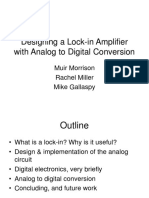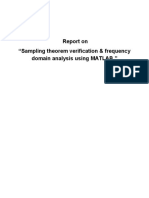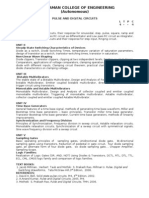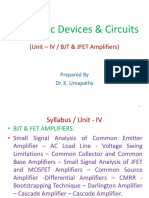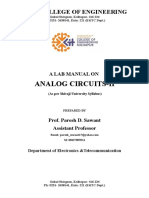Analog Electronics Introduction
Uploaded by
Ted MosbyAnalog Electronics Introduction
Uploaded by
Ted MosbyCHRIST
Deemed to be University
Syllabus
● Prerequisites: Basic Electronics,
Electronic Devices & Circuits
Excellence and Service
CHRIST
Deemed to be University
UNIT 1: OSCILLATORS AND TRANSISTOR SWITCHING
CIRCUITS
● Mechanism for start of oscillation and stabilization
of amplitude: Tank Circuit. Positive Feedback:
Barkhausen Criterion. RC phase shift Oscillator.
Wien bridge Oscillator. Analysis of LC Oscillators,
Colpitts, Hartley, Clapp oscillators. Frequency
range of RC and LC Oscillators. Quartz Crystal
Construction. Electrical equivalent circuit of
Crystal. Pierce crystal Oscillator circuit.
Excellence and Service
CHRIST
Deemed to be University
UNIT 1: OSCILLATORS AND TRANSISTOR SWITCHING
CIRCUITS
● Transistor switching times. (Delay, rise, storage
and fall time). Analysis of collector coupled
Astable, Monostable and Bistable multivibrators.
UJT Relaxation Oscillator.
Excellence and Service
CHRIST
Deemed to be University
Unit-2 LARGE SIGNAL AMPLIFIERS AND TUNED
AMPLIFIERS
● Power Amplifier: Definition and amplifier types –
efficiency – classification. Transformer coupled
Class A amplifier – Transformer coupled class –
B and class – AB amplifiers – Complementary
Symmetry – Push pull amplifier. Calculation of
efficiency, power output and dissipation. Amplifier
Distortion – Cross over distortion. Power of a
signal having distortion. Power Transistor heat
sinking.
Excellence and Service
CHRIST
Deemed to be University
TUNED AMPLIFIERS
● Tuned Amplifiers: Basic principle – Concept of
resonance – coil loses, unloaded and loaded Q of
tank circuits. Basic tuned amplifier using BJT – Q
factor – Selectivity – instability of tuned amplifier –
Stabilization techniques – Class C tuned
Amplifiers and their applications. Efficiency of
class C tuned amplifier.
Excellence and Service
CHRIST
Deemed to be University
TEXT BOOKS
● T1. David A. Bell, “Electronic Devices and Circuits”, 5th
Edition, OUP, 2008.
● T2. Millman J. and Halkias .C. " Integrated Electronics ",
Tata McGraw-Hill Publishing, 2000.
● T3. Sergio Franco, ”Design with Operational Amplifiers
and Analog Integrated Circuits”, 3ed, Tata Mc.Graw Hill,
2002.
● T4. Gayakwad, ”Op-Amps and Linear Integrated Circuits”,
4ed, Prentice Hall of India, 2002.
Excellence and Service
CHRIST
Deemed to be University
REFERENCE BOOKS
● R1. Donald A Neamen, “Electronic Circuit
Analysis and Design”, 3/e, TMH.
● R2. Behzad Razavi,” Design of Analog CMOS
IC”, 2nd Edition, Tata McGraw Hill, 2003.
● R3. David A. Bell, “Operational Amplifiers and
Linear ICs”, 3rd Edition, OUP, 2011.
● R4. David A. Johns, Ken Martin, “Analog
Integrated Circuit Design”, 2nd Edition, Wiley
India, 2008.
Excellence and Service
CHRIST
Deemed to be University
Which is the oscillator in our body ?
Excellence and Service
CHRIST
Deemed to be University
Excellence and Service
CHRIST
Deemed to be University
Which is the oscillator on our body ?
Excellence and Service
CHRIST
Deemed to be University
Wrist watch!
Excellence and Service
CHRIST
Deemed to be University
How is time kept for the country ?
Excellence and Service
CHRIST
Deemed to be University
Atomic Clock!
Excellence and Service
CHRIST
Deemed to be University
Atomic clocks
Excellence and Service
CHRIST
Deemed to be University
GPS signals
Excellence and Service
CHRIST
Deemed to be University
GAIN of an Amplifier
V input A V output
A = output / input
Excellence and Service
CHRIST
Deemed to be University
Barkhausen’s criteria
Excellence and Service
CHRIST
Deemed to be University
|A B | > 1
The Transistor Gain will adjust itself to give
sustained oscillations.
Initial design should be for AB > 1
Excellence and Service
CHRIST
Deemed to be University
|A B | < 1
Excellence and Service
CHRIST
Deemed to be University
|A B | = 1
Excellence and Service
CHRIST
Deemed to be University
Starting of oscillations
Excellence and Service
CHRIST
Deemed to be University
Starting of oscillations
Excellence and Service
CHRIST
Deemed to be University
Electrical Noise
Excellence and Service
CHRIST
Deemed to be University
Electrical Noise
Excellence and Service
CHRIST
Deemed to be University
Electrical Noise
Excellence and Service
CHRIST
Deemed to be University
Electrical Noise
● Noise power = KTB
Excellence and Service
CHRIST
Deemed to be University
Electrical Noise
Excellence and Service
CHRIST
Deemed to be University
TRANSISTOR BIASING
Excellence and Service
CHRIST
Deemed to be University
Position towards the ceiling
Excellence and Service
CHRIST
Deemed to be University
Position towards the floor
Excellence and Service
CHRIST
Deemed to be University
To get smooth , distortionless motion, it should be centred
Excellence and Service
CHRIST
Deemed to be University
To ensure, centering of Quescient Point
● VCE = 50% of Vcc
Excellence and Service
CHRIST
Deemed to be University
Divider Bias Circuit Design
Excellence and Service
CHRIST
Deemed to be University
Divider Bias Circuit Design
A) Ib = I1 +I2
B) Ib = I2 –I1
C) Ib = I1-I2
Excellence and Service
CHRIST
Deemed to be University
Divider Bias Circuit Design
A) Ie = Ic +Ib
B) Ie = Ic –Ib
C) Ie = Ib-Ie
Excellence and Service
CHRIST
Deemed to be University
Let Vcc = 12 V
Excellence and Service
CHRIST
Deemed to be University
Excellence and Service
CHRIST
Deemed to be University
Excellence and Service
CHRIST
Deemed to be University
Excellence and Service
CHRIST
Deemed to be University
Excellence and Service
CHRIST
Deemed to be University
Experiment # 0 (Basics)
● Increase Ib to 3 mA, measure VCE
● Decrease Ib to 0.2 mA, measure VCE
Excellence and Service
CHRIST
Deemed to be University
VRC VRE VCE Vcc= STATUS of
12V Transistor
Ic = ACTIVE REGION
/ CUT-
2mA OFF/SATURATIO
N
Ic=
3mA
Ic=
0.2mA
Excellence and Service
CHRIST
Deemed to be University
Barkhausen’s criteria
Excellence and Service
CHRIST
Deemed to be University
Oscillator configuration
Excellence and Service
CHRIST
Deemed to be University
RC PHASE SHIFT OSCILLATOR
Excellence and Service
CHRIST
Deemed to be University
FREQUENCY OF OSCILLATION
K = Rc / R
PRACTICAL VALUE OF f is
Excellence and Service
CHRIST
Deemed to be University
hfe
● hfe > 4K + 23 + 29/K ------- equ (1)
● To get the minimum value of hfe for oscillations,
=0
=0
Excellence and Service
CHRIST
Deemed to be University
= 2.6925 -------------- (2)
Substituting equ 2 in equ 1 ,
hfe (min) = 44.54
Hence for the circuit to oscillate, we must select a
transistor whose hfe min is > 44.54
Excellence and Service
CHRIST
Deemed to be University
QUIZ
● A transistor is used in an oscillator design with the
following hfe values:
A) Min 20, max 100
B) Min 40 max 150
C) Min 50 max 150
D) Min 60 max 200
Which transistor/transistors are suitable? Which will
you select ?
Excellence and Service
CHRIST
Deemed to be University
PROBLEM
● In a RC phase shift oscillator, the 3 section
phase shift network uses resistance each of 4.7
kohms and the capacitors each of 0.47uF. Find
the frequency of oscillation.
Excellence and Service
CHRIST
Deemed to be University
PROBLEM
● In a RC phase shift oscillator, the 3 section phase shift
network uses resistance each of 4.7 kohms and the
capacitors each of 0.47uF. Find the frequency of
oscillation.
● Rc not given, hence K cannot be determined. Therefore
use approx formula
Excellence and Service
CHRIST
Deemed to be University
PROBLEM
29. 413 Hz
Excellence and Service
CHRIST
Deemed to be University
PROBLEM
● Estimate the value of R and C for an output
frequency of 1 kHz in a RC phase shift oscillator .
Excellence and Service
CHRIST
Deemed to be University
PROBLEM
● Estimate the value of R and C for an output
frequency of 1 kHz in a RC phase shift oscillator .
Assume suitable value of capacitor , say
0.1 uF. Use approx formula
Excellence and Service
CHRIST
Deemed to be University
PROBLEM
● For RC phase shift oscillator, the feedback
network uses R = 6 K ohms and C = 1500 pF.
The collector resistance Rc = 18 K ohms.
Calculate the frequency of oscillations and
minimum value of hfe of the transistor.
Excellence and Service
CHRIST
Deemed to be University
RC PHASE SHIFT OSCILLATOR
Excellence and Service
CHRIST
Deemed to be University
Phase shift
Excellence and Service
CHRIST
Deemed to be University
Phase shift per section
Excellence and Service
CHRIST
Deemed to be University
Excellence and Service
CHRIST
Deemed to be University
● Vo = IR
● Vc = I Xc = I x 1/(2∏f RC )
● TAN (Ɵ ) = IXc /I R = 1/ (2∏fRC)
● f = 1/(2∏CR Tan(Ɵ)) = 1/ (2 ∏R C√3 )
Excellence and Service
CHRIST
Deemed to be University
LOADING EFFECT
Excellence and Service
CHRIST
Deemed to be University
APPLICATION
● Used for generating sinusoidal wave signals in
the AUDIO band
● It is used as a fixed frequency oscillator
Excellence and Service
CHRIST
Deemed to be University
ADVANTAGES & DISADVANTAGES
● ADVANTAGES :
1. Circuit is simple to design
● DISADVANTAGES:
1. Difficulty in tuning /varying the frequency
WHY ?
Excellence and Service
CHRIST
Deemed to be University
COLPITT OSCILLATOR
Excellence and Service
CHRIST
Deemed to be University
PHASE SHIFT IN THE TANK CIRCUIT
Excellence and Service
CHRIST
Deemed to be University
Operation
● The LC network is used to provide the necessary
phase shift to the feedback voltage
● LC network acts like a filter that passes the
oscillation frequency and blocks all other
frequencies
● The filter circuit resonates at the required
oscillation frequency
Excellence and Service
CHRIST
Deemed to be University
Operation
● For resonance
XL = XCT
where XCT = reactance of the total capacitance in parallel
with the inductor
wL = 1/wCT or 2∏ f L = 1 /(2∏ f CT )
or f = 1/ (2 ∏√ LCT ) where CT = C1C2 /(C1+C2)
Excellence and Service
CHRIST
Deemed to be University
● β = attenuation due to the voltage dividing effect
of L and C1
● β = Xc1 / ( XL1 – XC1)
● Required phase shift occurs when XC2 = XL1 –
XC1
● or β = Xc1/Xc2 = C2/C1
● |A β | = 1 or | A x C2/C1| = 1
● i.e A = C1/C2
β = C2/C1 and Amin = C1/C2 = hfe min
Excellence and Service
CHRIST
Deemed to be University
TANK Circuit
Excellence and Service
CHRIST
Deemed to be University
Damped oscillations
Excellence and Service
CHRIST
Deemed to be University
Tank or resonant circuit
Excellence and Service
CHRIST
Deemed to be University
Excellence and Service
CHRIST
Deemed to be University
Problem
● Find the frequency of oscillation of a
transistorized Colpitt oscillator having tank circuit
parameters as C1 = 150pF, C2 =1.5nF and L
=50uH.
Excellence and Service
CHRIST
Deemed to be University
Problem
● In a standard Colpitt oscillator as C1 = 0.1uF,
C2 =0.01uF and L =10uH. Determine
a) Freq of oscillation
b) Minimum gain required to start oscillation
Excellence and Service
CHRIST
Deemed to be University
Hartley Oscillator
Excellence and Service
CHRIST
Deemed to be University
Theory of operation
1. The inductors L1 and L2 have a
mutual coupling M which must be taken into
account in determining the equivalent inductance
for the resonant tank circuit.
L equ = L1 + L2 + 2M
2. The amplifier section uses an active device i.e.
transistor in CE configuration which provides a
gain A and phase shift of 180 degrees.
3. The tank circuit (L1,L2 and C) provides an
additional 180 degrees phase shift
Excellence and Service
CHRIST
Deemed to be University
PHASE SHIFT IN THE TANK CIRCUIT
Excellence and Service
CHRIST
Deemed to be University
Problem
● In a Hartley oscillator, L1 = 20uH, L2= 2mH, and
C is variable. Find the range of C if frequency is
to be varied from 1 MHz to 2.5 MHz. Neglect
mutual inductance.
Excellence and Service
CHRIST
Deemed to be University
Quartz crystal
Excellence and Service
CHRIST
Deemed to be University
Excellence and Service
CHRIST
Deemed to be University
Quartz crystal clock
Excellence and Service
CHRIST
Deemed to be University
Mounting mechanism
Excellence and Service
You might also like
- Service Manual Power Supply Unit Panasonic KX-TDA0104X62% (13)Service Manual Power Supply Unit Panasonic KX-TDA0104X134 pages
- Samsung BN68 Series Smart TV Users Manual enNo ratings yetSamsung BN68 Series Smart TV Users Manual en132 pages
- AIA10-Non-linear and Real Op-Amp CircuitsNo ratings yetAIA10-Non-linear and Real Op-Amp Circuits37 pages
- Chapter Three Op-Amp Characteristics and Applications: + Non-Inverting OutputNo ratings yetChapter Three Op-Amp Characteristics and Applications: + Non-Inverting Output17 pages
- Unit Iii: Analysis of Discrete Time SignalsNo ratings yetUnit Iii: Analysis of Discrete Time Signals22 pages
- Designing A Lock-In Amplifier With Analog To Digital ConversionNo ratings yetDesigning A Lock-In Amplifier With Analog To Digital Conversion27 pages
- Section 12-1 Analog-to-Digital Conversion: SolutionNo ratings yetSection 12-1 Analog-to-Digital Conversion: Solution4 pages
- Department of Electronics & Telecommunication: Presented By: Valluri Bhavana MSC - Etc, 1 Semester Roll No: Pg19Etc-002No ratings yetDepartment of Electronics & Telecommunication: Presented By: Valluri Bhavana MSC - Etc, 1 Semester Roll No: Pg19Etc-00222 pages
- UNIT-4 Lecture-1: Log, - Anti Log Amplifiers, Analog Multipliers and Their ApplicationsNo ratings yetUNIT-4 Lecture-1: Log, - Anti Log Amplifiers, Analog Multipliers and Their Applications13 pages
- Report On "Sampling Theorem Verification & Frequency Domain Analysis Using MATLAB."No ratings yetReport On "Sampling Theorem Verification & Frequency Domain Analysis Using MATLAB."8 pages
- Lab Requirements of Ece: Infrastructure Requirement As Per Aicte NormsNo ratings yetLab Requirements of Ece: Infrastructure Requirement As Per Aicte Norms4 pages
- UNIT - 3: Fast-Fourier-Transform (FFT) Algorithms: Dr. Manjunatha. PNo ratings yetUNIT - 3: Fast-Fourier-Transform (FFT) Algorithms: Dr. Manjunatha. P100 pages
- Evaluator Report Part B Ug Tier I v0 PDFNo ratings yetEvaluator Report Part B Ug Tier I v0 PDF11 pages
- Unit 5 - RC Coupled Amplifier by Dr. Meenakshi RanaNo ratings yetUnit 5 - RC Coupled Amplifier by Dr. Meenakshi Rana18 pages
- Unit-III-Signal Generators & Wave Analyzers PDF100% (1)Unit-III-Signal Generators & Wave Analyzers PDF33 pages
- E. Ambikairajah Australia: Part A: Signal ProcessingNo ratings yetE. Ambikairajah Australia: Part A: Signal Processing152 pages
- FM Transmission: P.J. Pardeshi Asst. Professor Mitcoe100% (2)FM Transmission: P.J. Pardeshi Asst. Professor Mitcoe84 pages
- Transducers Instrumentation: Second EditionNo ratings yetTransducers Instrumentation: Second Edition11 pages
- Transistor BC107 Practical Common EmitteNo ratings yetTransistor BC107 Practical Common Emitte9 pages
- Unit 4 Power Converters and Renewable EnergyNo ratings yetUnit 4 Power Converters and Renewable Energy56 pages
- Subject Title: Analog Circuits: 18EC42 Model Question Paper-2 With Effect From 2019-20 (CBCS Scheme)No ratings yetSubject Title: Analog Circuits: 18EC42 Model Question Paper-2 With Effect From 2019-20 (CBCS Scheme)3 pages
- EDC Notes or ECAD (Similar To Vakil Sir Notes) Electronics, EXTC Branch. Engineering Group100% (1)EDC Notes or ECAD (Similar To Vakil Sir Notes) Electronics, EXTC Branch. Engineering Group22 pages
- Mapping of Virtual Laboratories of Electronics and Communication EngineeringNo ratings yetMapping of Virtual Laboratories of Electronics and Communication Engineering6 pages
- II BTECH - I SEM - ECE - EDC - THEORY & QUIZ QUESTIONS - MID 2 - Students PDFNo ratings yetII BTECH - I SEM - ECE - EDC - THEORY & QUIZ QUESTIONS - MID 2 - Students PDF19 pages
- NE592 Video Amplifier: Marking DiagramsNo ratings yetNE592 Video Amplifier: Marking Diagrams11 pages
- Design of A 14-Bit Pipelined ADC Using Ring AmplifierNo ratings yetDesign of A 14-Bit Pipelined ADC Using Ring Amplifier4 pages
- tm2254 - 9230, 9330, 9430,9530 and 9630tractors Diagnos C Technical Manual - A110-1-CAB Control Unit (SE10A) (W500, W501, W504)No ratings yettm2254 - 9230, 9330, 9430,9530 and 9630tractors Diagnos C Technical Manual - A110-1-CAB Control Unit (SE10A) (W500, W501, W504)3 pages
- Aplicacion Variadores de Velocidad Fluke 289No ratings yetAplicacion Variadores de Velocidad Fluke 2895 pages
- Genz Benz Shuttlemax 9.2 Bass Amp ManualNo ratings yetGenz Benz Shuttlemax 9.2 Bass Amp Manual10 pages
- Program Studi Teknik Elektro Universitas UdayanaNo ratings yetProgram Studi Teknik Elektro Universitas Udayana26 pages
- Service Manual Power Supply Unit Panasonic KX-TDA0104XService Manual Power Supply Unit Panasonic KX-TDA0104X
- Chapter Three Op-Amp Characteristics and Applications: + Non-Inverting OutputChapter Three Op-Amp Characteristics and Applications: + Non-Inverting Output
- Designing A Lock-In Amplifier With Analog To Digital ConversionDesigning A Lock-In Amplifier With Analog To Digital Conversion
- Section 12-1 Analog-to-Digital Conversion: SolutionSection 12-1 Analog-to-Digital Conversion: Solution
- Department of Electronics & Telecommunication: Presented By: Valluri Bhavana MSC - Etc, 1 Semester Roll No: Pg19Etc-002Department of Electronics & Telecommunication: Presented By: Valluri Bhavana MSC - Etc, 1 Semester Roll No: Pg19Etc-002
- UNIT-4 Lecture-1: Log, - Anti Log Amplifiers, Analog Multipliers and Their ApplicationsUNIT-4 Lecture-1: Log, - Anti Log Amplifiers, Analog Multipliers and Their Applications
- Report On "Sampling Theorem Verification & Frequency Domain Analysis Using MATLAB."Report On "Sampling Theorem Verification & Frequency Domain Analysis Using MATLAB."
- Lab Requirements of Ece: Infrastructure Requirement As Per Aicte NormsLab Requirements of Ece: Infrastructure Requirement As Per Aicte Norms
- UNIT - 3: Fast-Fourier-Transform (FFT) Algorithms: Dr. Manjunatha. PUNIT - 3: Fast-Fourier-Transform (FFT) Algorithms: Dr. Manjunatha. P
- Unit 5 - RC Coupled Amplifier by Dr. Meenakshi RanaUnit 5 - RC Coupled Amplifier by Dr. Meenakshi Rana
- E. Ambikairajah Australia: Part A: Signal ProcessingE. Ambikairajah Australia: Part A: Signal Processing
- FM Transmission: P.J. Pardeshi Asst. Professor MitcoeFM Transmission: P.J. Pardeshi Asst. Professor Mitcoe
- 150 Fascinating Viva Questions & Answers on Circuit theory.From Everand150 Fascinating Viva Questions & Answers on Circuit theory.
- Subject Title: Analog Circuits: 18EC42 Model Question Paper-2 With Effect From 2019-20 (CBCS Scheme)Subject Title: Analog Circuits: 18EC42 Model Question Paper-2 With Effect From 2019-20 (CBCS Scheme)
- EDC Notes or ECAD (Similar To Vakil Sir Notes) Electronics, EXTC Branch. Engineering GroupEDC Notes or ECAD (Similar To Vakil Sir Notes) Electronics, EXTC Branch. Engineering Group
- Mapping of Virtual Laboratories of Electronics and Communication EngineeringMapping of Virtual Laboratories of Electronics and Communication Engineering
- II BTECH - I SEM - ECE - EDC - THEORY & QUIZ QUESTIONS - MID 2 - Students PDFII BTECH - I SEM - ECE - EDC - THEORY & QUIZ QUESTIONS - MID 2 - Students PDF
- Design of A 14-Bit Pipelined ADC Using Ring AmplifierDesign of A 14-Bit Pipelined ADC Using Ring Amplifier
- tm2254 - 9230, 9330, 9430,9530 and 9630tractors Diagnos C Technical Manual - A110-1-CAB Control Unit (SE10A) (W500, W501, W504)tm2254 - 9230, 9330, 9430,9530 and 9630tractors Diagnos C Technical Manual - A110-1-CAB Control Unit (SE10A) (W500, W501, W504)











